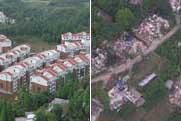China
Qinghai-Tibet Railway: World marvel
Source: CCTV.com
07-01-2006 11:45
With the first run of China's Qinghai-Tibet railway, transport in the Tibet Autonomous Region begins a new era. The miracle of engineering is also a marvel of environmental protection, and a testament to human ingenuity.
This is the highest plateau in the world.
A land of legends, and home of spirits.
Beautiful and sacred, the stuff of dreams.
And a new railway is bringing the dreams within reach.
This is the first railway linking the Tibet Autonomous Region with the outside world.
The project was initiated in the 1950s.
It has a total investment of over 3 billion US dollars.
On October 12th, 2005, the main track was completed, the achievement of 100 thousands workers.
The 1,100-kilometer railway from Golmud in Qinghai Province to Lhasa, the capital of the Tibet Autonomous Region, is the highest rail route in the world.
Some 960 kilometers of its tracks are 4,000 meters above sea level. The highest point is 5,072 meters.
On the world's highest plateau, the Qinghai-Tibet railway has set records.
The Fenghoushan Tunnel, 4,900 meters above sea level, is the world's highest permafrost tunnel.
The Kunlun Mountain Tunnel, 4,700 meters above sea level, is the world's longest permafrost tunnel.
And Tanggula Station, 5,000 meters above sea level, is the world's highest railway station.
The railway is a miracle of engineering, but the project as a whole is a marvel in environmental protection and a testament to human ingenuity.
The tracks cut across one of the world's most fragile ecosystems.
Five nature reserves along its route.
And one is the Hohxil Reserve, the largest habitat of the endangered Tibetan antelope.
Nearly 200-million US dollars have been invested to prevent the railway from disturbing the environment.
Scientists and engineers worked together to minimize impact on the wildlife.
Construction worker said: "In this section, we built bridges high enough to let the wild animals pass underneath. And in other sections, we redesigned the rail bed. The wider rail bed makes it easier for antelopes to cross."
Other challenges are permafrost and thin oxygen.
Heat conductors, ventilation ditches and thermal insulation protect the frozen soil.
Special oxygen supplies are laid in for passenger comfort.
The Qinghai-Tibet Railway was a hot topic even before the blueprints were drawn, and will remain so for years to come.
And when full service starts in 2007, major cities including Beijing, Shanghai and Guangzhou, will be connected to Lhasa by the rail-link.
Editor:Wang Ping



